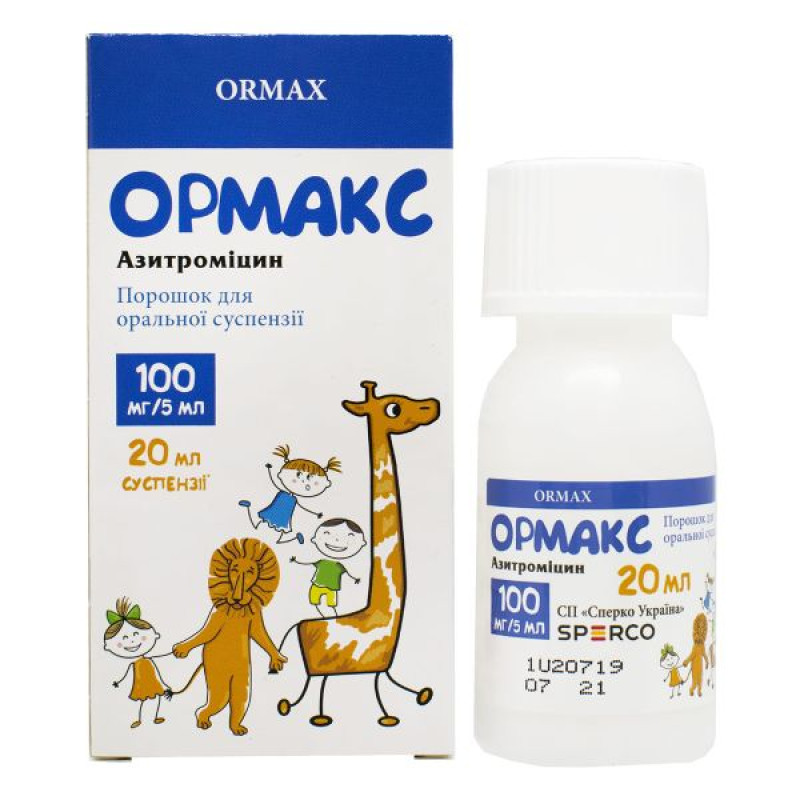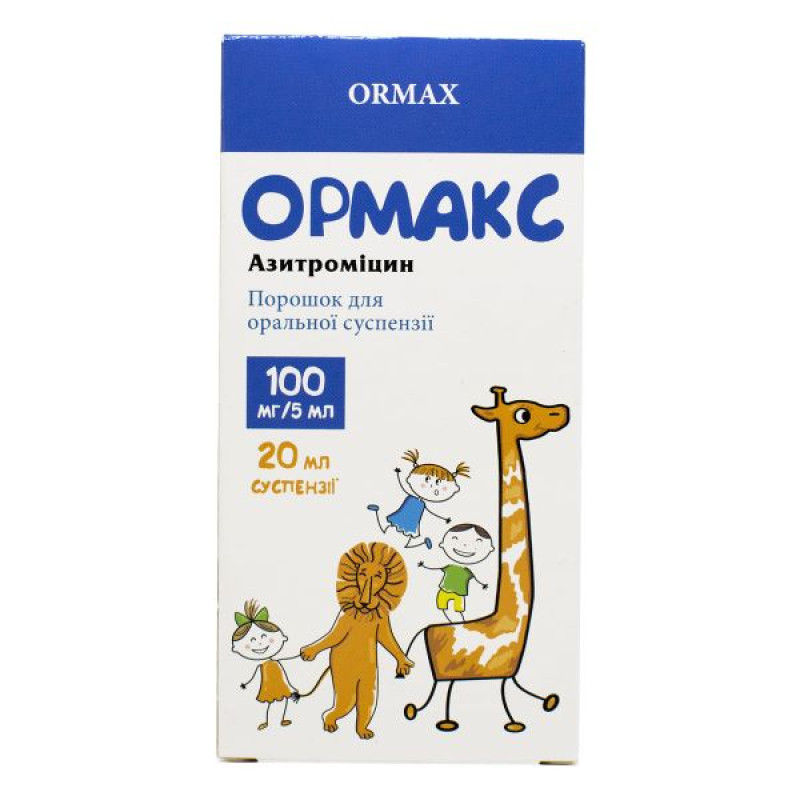Ormax powder for suspension preparation 100 mg/5 ml container 11.34 g d/p 20 ml suspension No. 1

Ormax powder for oral suspension is indicated for the treatment of infections caused by microorganisms sensitive to azithromycin:
ENT infections (bacterial pharyngitis/tonsillitis, sinusitis, otitis media); respiratory tract infections (bacterial bronchitis, community-acquired pneumonia); skin and soft tissue infections: erythema migrans (initial stage of Lyme disease), erysipelas, impetigo, secondary pyodermatoses.Composition
Active ingredient: azithromycin;
5 ml of suspension contain 100 mg of azithromycin (in the form of dihydrate);
Excipients: sodium benzoate (E 211), sucrose or sucrose with colloidal silicon dioxide, sodium phosphate, hydroxypropyl cellulose, xanthan gum, colloidal silicon dioxide, fruit flavor "apricot". Does not contain dyes.
Contraindication
Hypersensitivity to the active substance, other components of the drug or to other macrolide antibiotics. Given the theoretical possibility of ergotism, azithromycin should not be used simultaneously with ergot derivatives.
Method of application
To prepare the suspension, the container with the powder must be turned over so that the powder separates from the bottom, then add 15 ml of boiled water at room temperature using a dosing syringe. After adding water, close the bottle and shake thoroughly until a homogeneous suspension is formed. After that, the date of preparation of the suspension must be written in a special frame on the label. Store the finished suspension in the refrigerator. Shake the suspension well before each use. Take the suspension orally once a day 1 hour before or 2 hours after a meal. Immediately after using the suspension, the child must be given a few sips of liquid to wash away and swallow any remaining suspension in the mouth.
Application features
Pregnant women
Azithromycin should be prescribed during pregnancy only if absolutely necessary.
Children
Ormax in the form of a suspension of 100 mg / 5 ml should be used for children weighing from 5 to 15 kg. For children weighing more than 15 kg, use Ormax in the form of a suspension of 200 mg / 5 ml.
Drivers
There is no evidence that azithromycin may impair the ability to drive or operate machinery, but the possibility of developing adverse reactions such as dizziness, drowsiness, and visual disturbances should be taken into account.
Overdose
Symptoms: In case of an overdose of azithromycin, severe nausea, vomiting, diarrhea, abdominal pain, and reversible hearing loss are observed.
Treatment: Administration of activated charcoal and general symptomatic and supportive treatment measures.
Side effects
Blood and lymphatic system disorders: infrequently - leukopenia, neutropenia, eosinophilia; not known - thrombocytopenia, hemolytic anemia; mental disorders: infrequently - nervousness, insomnia; rarely - agitation; not known - aggressiveness, restlessness, increased psychomotor activity, delirium, hallucinations; nervous system disorders: often - headache; infrequently - dizziness, drowsiness, paresthesia, dysgeusia; not known - fainting, convulsions, anosmia, parosmia, ageusia, myasthenia gravis, hypoesthesia; visual disorders: often - visual disturbances; hearing disorders: infrequently - hearing impairment, vertigo; not known - hearing impairment, including deafness and/or tinnitus; cardiac disorders: infrequently - palpitations; not known - torsade de pointes, arrhythmia, including ventricular tachycardia (it has been found that they are also caused by other macrolide antibiotics), prolongation of the QT interval on the ECG; from the vascular system: infrequently - hot flashes; not known - arterial hypotension; from the respiratory system: infrequently - dyspnea, epistaxis, respiratory function disorders, rhinitis; from the digestive tract: very often - diarrhea; often - nausea, vomiting, abdominal discomfort (pain / cramps); infrequently - gastritis, flatulence, dyspepsia, dysphagia, dry mouth, eructation, mouth ulcers, hypersecretion of saliva, anorexia, constipation; not known - tongue discoloration, pancreatitis;Interaction
Azithromycin should be administered with caution simultaneously with other drugs that may prolong the QT interval.
Cetirizine: In healthy volunteers, concomitant administration of azithromycin for 5 days with cetirizine 20 mg at steady state did not result in any pharmacokinetic interaction or significant changes in the QT interval.
Didanosine: Coadministration of 1200 mg daily doses of azithromycin with didanosine had no effect on the pharmacokinetics of didanosine compared to placebo.
Ergot. Given the theoretical possibility of ergotism, the simultaneous administration of azithromycin with ergot derivatives is not recommended.
Storage conditions
Store at a temperature not exceeding 25 °C.
Keep out of reach of children.
Store the prepared suspension for no more than 5 days at a temperature of 2°C to 8°C.
Keep out of reach of children.
Shelf life - 2 years.
The shelf life of the finished suspension is 5 days.
There are no reviews for this product.
There are no reviews for this product, be the first to leave your review.
No questions about this product, be the first and ask your question.







